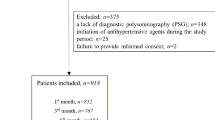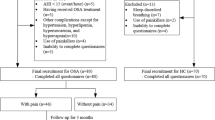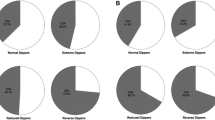Abstract
The long-term effect of treatment with continuous positive airway pressure (CPAP) on erectile function was assessed in 60 patients with obstructive sleep apnea syndrome (OSAS). Severity of OSAS was evaluated by respiratory disturbance index (RDI) and minimal oxygen saturation (OxiMin). Severity of erectile dysfunction (ED) was assessed with the five question International Index of Erectile Function (IIEF-5) before and after CPAP treatment. Subjects were categorized into three groups on the basis of the change in IIEF-5 score: Group 1, no change (n=37); Group 2, improvement from 10±5.65 to 19.1±5.7, P<0.01 (n=12); Group 3, worsening from 19.9±4.7 to 9.5±7.8, P<0.01 (n=11). Group 2 had significantly higher RDI and lower OxiMin than the other groups, and was also more compliant and satisfied with CPAP. Change in IIEF-5 with CPAP treatment was negatively correlated (Pearson coefficient) with OxiMin (r=−0.374), and positively correlated with adherence to CPAP treatment (r=0.689). In conclusion, in selected patients, CPAP treatment for OSAS may by itself have a positive effect on erectile function by improving respiration during sleep. Predictors of erectile improvement include high RDI, low OxiMin, and CPAP compliance.
This is a preview of subscription content, access via your institution
Access options
Subscribe to this journal
Receive 8 print issues and online access
$259.00 per year
only $32.38 per issue
Buy this article
- Purchase on Springer Link
- Instant access to full article PDF
Prices may be subject to local taxes which are calculated during checkout


Similar content being viewed by others
References
Anon. Impotence. NIH Consens Statement 1992; 10: 1–33.
Ayta IA, McKinlay JB, Krane RJ . The likely worldwide increase in erectile dysfunction between 1995 and 2025 and some possible policy consequences. BJU Int 1999; 84: 50–56.
Lavie P . Incidence of sleep apnea in a presumably healthy working population: significant relationship with excessive day time sleepiness. Sleep 1983; 6: 312–318.
Nieto FJ et al. Association of sleep disordered breathing, sleep apnea and hypertension in a large community based study. JAMA 2000; 283: 1829–1836.
Shahar E et al. Sleep-disordered breathing and cardiovascular disease: cross-sectional results of the Sleep Heart Health Study. Am J Resp Crit Care Med 2001; 163: 19–25.
Brooks D et al. Obstructive sleep apnea as a cause of systemic hypertension. Evidence from a canine model. J Clin Invest 1997; 99: 106–109.
Dyken ME et al. Investigating the relationship between stroke and obstructive sleep apnea. Stroke 1996; 27: 401–407.
Horner RL et al. Immediate effects of arousal from sleep on cardiac autonomic outflow in the absence of breathing in dogs. J Appl Physiol 1995; 79: 151–162.
Katragadda S et al. Neural mechanism of the pressor response to obstructive and nonobstructive apnea. J Appl Physiol 1997; 83: 2048–2054.
Margel D, Cohen M, Livne PM, Pillar G . Severe but not mild obstructive sleep apnea syndrome is associated with erectile dysfunction. Urology 2004; 63: 545–549.
Pressmen MR et al. Problems in the interpretation of nocturnal penile tumescence studies: disruption of sleep by occult sleep disorders. J urol 1986; 136: 595–598.
Hirshkowitz M et al. Prevalence of sleep apnea in men with erectile dysfunction. Urology 1990; 36: 232–234.
Karacan I, Karatas M . Erectile dysfunction in sleep apnea and response to CPAP. J Sex Marital Ther 1995; 21: 239–247.
Perimenis P et al. Erectile dysfunction in men with obstructive sleep apnea syndrome: a randomized study of the efficacy of sildenafil and continuous positive airway pressure. Int J Impot Res 2004; 16: 256–260.
Lue TF . Erectile dysfunction. N Engl J Med 2000; 342: 1802–1813.
Fanfulla F et al. Erectile dysfunction in men with obstructive sleep apnea: an early sign of nerve involvement. Sleep 2000; 23: 775–781.
Mayer P et al. Peripheral neuropathy in sleep apnea: a tissue marker of the severity of nocturnal desaturation. Am J Resp Crit Care Med 1999; 159: 213–219.
Karen C, McCowen A, Malhotra . The correlation between obstructive sleep apnea and low gonadotropin secretion in men. Sleep Med 2003; 4: 83–84.
Cheshier K et al. Factors impairing day time performance in patients with sleep apnea hypopnea syndrome. Arc Int Med 1992; 152: 538–541.
Akashiba T et al. Relationship between quality of life and mood or depression in patients with severe obstructive sleep apnea syndrome. Chest 2002; 122: 861–865.
Santamaria JD, Prior JC, Fleetham JA . Reversible reproductive dysfunction in men with obstructive sleep apnea. Clin endocrinol 1988; 28: 461–470.
Popescu G, Latham M, Allgar V, Elliott MW . Continuous positive airway pressure for sleep apnoea/hypopnoea syndrome: usefulness of a 2 week trial to identify factors associated with long term use. Thorax 2001; 56: 727–733.
Kourembanas S, Morita T, Liu Y, Christou H . Mchanisms by which oxygen regulates gene expression and cell–cell interaction in the vasculature. Kidney Int 1997; 51: 438.
Moreland RB . Is there a role of hypoxemia in penile fibrosis: a viewpoint presented to the Society for the Study of Impotence. Int J Impot Res 1998; 10: 113.
Kim N et al. Oxygen tension regulates the nitric oxide pathway: physiological role in penile erection. J Clin Invest 1993; 91: 437–440.
Sajkov D et al. Continuous positive airway pressure treatment improves pulmonary hemodynamics in patients with obstructive sleep apnea. Am J Resp Crit Care Med 2002; 165: 152–158.
Schulz R et al. Decrease plasma levels of nitric oxide derivatives in obstructive sleep apnoea: response to CPAP therapy. Thorax 2000; 55: 1046–1051.
Fletcher EC . Sympathetic over activity in etiology of hypertension of obstructive sleep apnea. Sleep 2003; 26: 9–15.
Luboshitzky R et al. Pituitary-gonadal function in men with obstructive sleep apnea. The effect of continuous positive airways pressure treatment. Neuro Endocrinol Lett 2003; 24: 463–467.
Patel SR et al. Continuous positive airway pressure therapy for treating sleepiness in a diverse population with obstructive sleep apnea: results of a meta-analysis. Arch Intern Med 2003; 163: 565–571.
Siroky MB, Azadzoi KM . Vasculogenic erectile dysfunction: newer therapeutic strategies. J Urol 2003; 170: S24–S30.
Author information
Authors and Affiliations
Corresponding author
Rights and permissions
About this article
Cite this article
Margel, D., Tal, R., Livne, P. et al. Predictors of erectile function improvement in obstructive sleep apnea patients with long-term CPAP treatment. Int J Impot Res 17, 186–190 (2005). https://doi.org/10.1038/sj.ijir.3901268
Received:
Revised:
Accepted:
Published:
Issue Date:
DOI: https://doi.org/10.1038/sj.ijir.3901268
Keywords
This article is cited by
-
Erectile Dysfunction and Sexual Hormone Levels in Men With Obstructive Sleep Apnea: Efficacy of Continuous Positive Airway Pressure
Archives of Sexual Behavior (2016)
-
Effects of nasal continuous positive airway pressure therapy on partners’ sexual lives
European Archives of Oto-Rhino-Laryngology (2016)
-
Obstructive sleep apnea symptoms beyond sleepiness and snoring: effects of nasal APAP therapy
Sleep and Breathing (2012)
-
Erectile dysfunction in severe sleep apnea patients and response to CPAP
International Journal of Impotence Research (2010)
-
Schlafapnoe in der Urologie
Der Urologe (2009)



